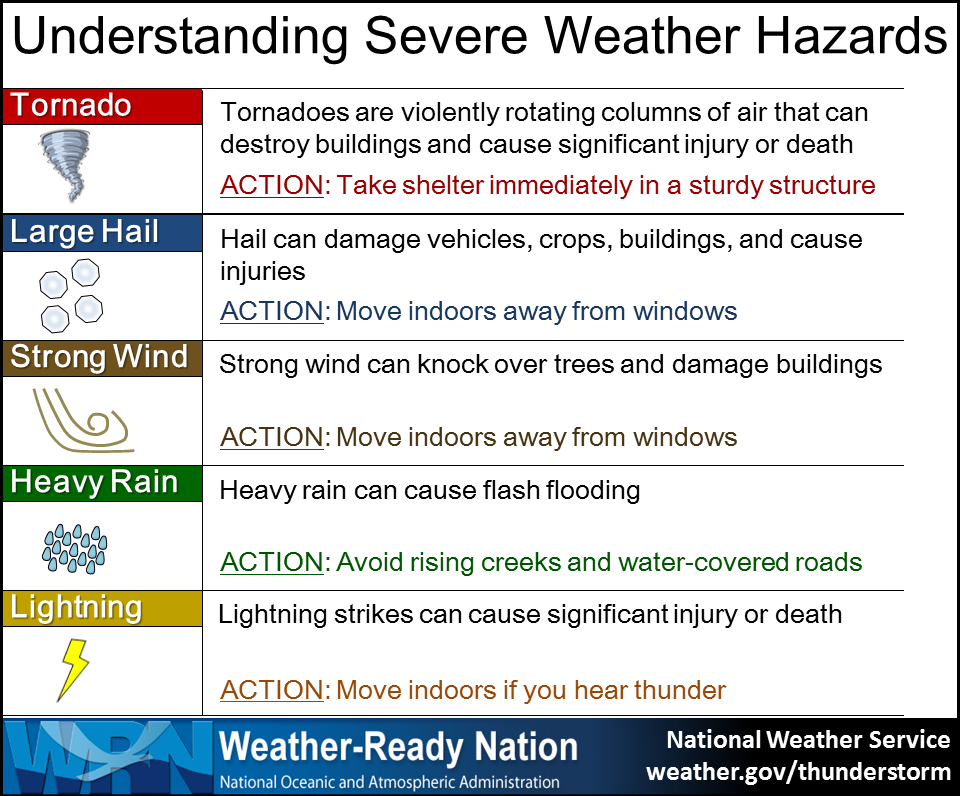Please help the National Weather Service spread these important safety messages on social media! Everyone is welcome to use the text and images provided below to help the NWS build a Weather-Ready Nation.
Facebook
A tornado is a narrow, violently rotating column of air that extends from the base of a thunderstorm to the ground. http://www.nssl.noaa.gov/education/svrwx101/tornadoes/ #TornadoScience
Twitter
A tornado is a narrow, violently rotating column of air that extends from the base of a thunderstorm to the ground. http://www.nssl.noaa.gov/education/svrwx101/tornadoes/ #TornadoScience

Facebook
A tornado WATCH means BE PREPARED. If there is a tornado watch, tornadoes are possible! Pay extra close attention to the weather and be ready to act. Preparing ahead of time helps to save lives! weather.gov/safety/tornado-ww #SpringSafety
Twitter
Watch means BE PREPARED. Preparation helps to save lives! weather.gov/safety/tornado-ww #SpringSafety

Facebook
A tornado WARNING means TAKE ACTION NOW. If there is a tornado warning, a tornado is imminent or already occurring. Seek shelter immediately, move to an interior room on the lowest floor of a sturdy building. Avoid windows and cover your head to protect yourself from flying debris. Take Action! Acting early helps to save lives! #SpringSafety weather.gov/safety/tornado-during
Twitter
A tornado WARNING means TAKE ACTION NOW and seek shelter immediately. weather.gov/safety/tornado-during #SpringSafety

Facebook
If your area is under a tornado warning, what should you do? You may only have a few minutes to get to safety. Learn what to do with this short video. #SpringSafety
https://www.youtube.com/watch?v=_5TiTfuvotc&feature=youtu.be
Twitter
What should you do during a tornado warning? https://www.youtube.com/watch?v=_5TiTfuvotc&feature=youtu.be #SpringSafety
Facebook
If you are impacted by tornado damage, there are a few important things to remember. Listen to local officials. Stay up-to-date on the forecast. Watch for debris and downed power lines. Use flashlights instead of candles for to avoid starting fires. weather.gov/safety/tornado-after #SpringSafety
Twitter
If you are impacted by tornado damage, there are a few important things to remember. weather.gov/safety/tornado-after

Facebook
Tornadoes can occur at any time of day or night. The nighttime hours are particularly dangerous because most people are sleeping. Wireless Emergency Alerts on your cell phone alerting you to dangerous weather can save your life. Find out more at https://www.ready.gov/alerts #SpringSafety
Twitter
Keep Wireless Emergency Alerts enabled on your cell phone. Find out more at https://www.ready.gov/alerts #SpringSafety

Facebook
Tornadoes can occur at any time of day or night. The nighttime hours are particularly dangerous because most people are sleeping. An alarm will sound on the NOAA Weather Radio when a Tornado Warning is issued. Having the radio near your bed will alert you to danger, waking you up when danger is near. http://www.nws.noaa.gov/nwr/ #SpringSafety
Twitter
Get severe weather warnings at night with a NOAA Weather Radio. www.nws.noaa.gov/nwr/ #SpringSafety

Facebook
A tornado WATCH means BE PREPARED. A tornado WARNING means TAKE ACTION. If there is a tornado watch pay extra close attention to the weather and be ready to act, because tornadoes are possible. If there is a tornado warning, find shelter immediately, and move to an interior room on the lowest floor of a sturdy building, because a tornado is occurring or will shortly. Avoid windows and cover your head to protect yourself from flying debris. Acting early helps to save lives! weather.gov/safety/tornado-ww
Twitter
Watch means BE PREPARED. Warning means TAKE ACTION. weather.gov/safety/tornado-ww #SpringSafety

Facebook
Do you know your risk for severe weather? See the severe weather outlooks issued by the Storm Prediction Center @NWSSPC #SpringSafety http://www.spc.noaa.gov/
Twitter
Know your risk for severe weather? See the Storm Prediction Center @NWSSPC http://www.spc.noaa.gov #SpringSafety

Facebook
Tornadoes, large hail, strong winds, flooding, and lightning are all hazards associated with severe weather. Severe weather has been reported in all 50 states, so no matter where you are, make sure you are prepared! weather.gov/safety/thunderstorm
Twitter
Severe weather can occur anywhere. Wherever you are, be prepared! weather.gov/safety/thunderstorm #SpringSafety

Facebook
Make a severe weather plan before you need it! Your family may not be together when a disaster strikes so it is important to plan in advance: how you will get to a safe place; how you will contact one another; how you will get back together; and what you will do in different situations. To find out how, visit https://www.ready.gov/make-a-plan #SpringSafety Photo: FEMA
Twitter
How will you stay in touch during a disaster? Make a plan! https://www.ready.gov/make-a-plan #SpringSafety (photo @fema)

Facebook
What’s a watch? What’s a warning? Learn the difference between a tornado watch and warning in this short video.
https://www.youtube.com/watch?v=x3V3HZBs1Y4
Twitter
Learn the difference between a tornado watch and warning. https://www.youtube.com/watch?v=x3V3HZBs1Y4 #SpringSafety
Facebook
Did you know that they are many different types of tornadoes? Learn all about them in the infographic below, and visit http://www.weather.gov/jetstream/tornado for more tornado facts. #TornadoScience
Twitter
Did you know that they are many different types of tornadoes? Learn all about them in the infographic below, and visit http://www.weather.gov/jetstream/tornado for more tornado facts. #TornadoScience
